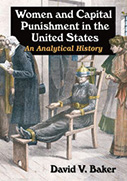Women and Capital Punishment in the United States: An Analytical History

Author: David V. Baker
Publisher: Jefferson, NC: McFarland & Company, Inc., 2016. 440p.
Reviewer: Ben Stickle | September 2016
Over the last several decades, capital punishment has been a topic of intense debate in the United States. Scholars, practitioners, and society itself have engaged in lengthy debates on the merits, procedures, and circumstances surrounding capital punishment. This debate has generated volumes of written work in the form of opinions, scholarly research, and legal findings. While the amount of information on capital punishment currently available is vast, an analysis of women who have been executed is curiously lacking. Rather, the majority of research on capital punishment focuses on men and pays scant attention to women. David V. Baker here provides a thorough and complete sociological and historical analytical narrative of women who have been executed, with the aim of correcting and clarifying the incomplete and distorted picture of capital punishment.
There are several reasons that women and capital punishment have received trivial investigation. First, comparatively, there have been few women who have been executed. In fact, less than three percent of all documented executions since 1632 involved women (p. 31); and in the 20th century, women account for only one half of one percent (0.5%) of all executions (p. 377). However, Baker contends that despite the small number of women who have been legally executed, it is vital to “bring voice to this forgotten population” through the lens of “race, gender, and class oppression in American capital justice” (p. 2).
The second reason women have received little attention in the literature is the lack of data on the circumstances surrounding charges, trials, and executions. Moreover, what data are available are from a variety of sources, making a cohesive understanding of the circumstances difficult. In this text Baker utilizes nearly two dozen academic sources and scores of government records to create what is likely the largest and most accurate collection of data on the executions of women in America. Therein lies the strength of the text and what is likely the greatest contribution to the literature and research on capital punishment.
Baker divides his extensive text (covering 430 pages) into three sections: 1) Theoretical and Empirical Frameworks; 2) Historical Context; and 3) Wrongful Convictions, Judicial Commutations, Executive Clemency, and Women on Death Row Today. The first section provides charts, tables, and summaries of the data Baker collected that identify the characteristics of executed women, including race and age of offender, criminal offence, method and location of execution, victim information, and more. This provides a helpful overview of the circumstances surrounding executions and provides a single source of data for future scholarly work.
The first section of the text also identifies Baker’s theoretical perspective that “[t]he capital justice system is a male-dominated institution designed to maintain the patriarchal social order by controlling women with the imposition of lethal violence—the ruthlessness of white male supremacy is a historically enduring feature of American capital justice” (p. 10). Indeed, this text is saturated with seeming contempt for the criminal justice system, and severe disdain for capital punishment and even white males generally. While this theoretical perspective is acknowledged within social science research, the extent to which Baker emphasizes this theory, which colors every analysis of capital punishment—seemingly unable to identify any women who may be deserving of the death penalty no matter the circumstances of their crime—may leave some readers struggling to accept his approach. Moreover, one of the dangers of analytical historical accounts is clearly evident throughout the text: erring on the side of dogma rather than using history to support a theoretical perspective.
The second section of the text, Historical Context, discusses women executed during three historical periods. The first historical period comprises executions from 1632 to 1759, the second period looks at capital punishment between 1760 and 1899, and the third historical period discusses executions between 1900 and 2014. Each of the three historical periods begins with a broad overview of the historical events surrounding the time period, providing the reader with a context for the information presented and helping to establish the cultural and social norms of the time and location. The text then provides detailed accounts of many of the cases and the events surrounding the crime, conviction, and punishment of women during that time period. Each of these accounts is categorized into several themes, including race, type of criminal accusation, and—in some cases—even smaller historical periods.
The author rarely returns to a broad view of history and makes almost no general conclusions about the themes or time periods. This method, providing a big picture overview of the historical events of the time followed by a series of—at times seemingly—weakly related accounts of capital punishment with limited conclusions or accounts of the number of cases discussed, creates an impression of disjointedness. Further, the text moves in and out of analysis by race, time periods, and crime type without identifying how these themes were recognized or developed and why they are, or are not, used in other situations.
Throughout the second section of the text, women are delineated into two categories: black and white. While it is important to understand the historical contexts within which each race experienced life and how others viewed and responded to them, the consistent delineation may harm rather than enhance understanding. For example, the author discusses white women executed for infanticide, and then some fifteen pages later discusses the same offenses by black women; and yet he fails to draw connections of similarity or difference. Because the two are rarely discussed in the same context, a comparison of the differences between races is, therefore, difficult to understand.
During the third historical trend (1900-2014), fifty-four women received the death penalty. This represents about 0.50% of the “more than 8,000 executions” of men and women during the period (p. 135). Moreover, there were no executions of black women for over 40 years (1960-2001). However, despite the nearly minuscule portion of women executed since 1900 and the non-existent executions of black women for nearly 40 years, the author indicts the “justice system as a primary enforcer of patriarchal rule in this country” declaring “it will not diminish” until certain “substantive protections intended to minimize gender bias in the capital system” (p. 377) are accomplished! He further states that there is a “systematic oppression” and “exploitation of women within [the] capital punishment system” (p. 378). While the small number of women executed—compared to men—during this period does not indicate insignificance, Baker fails to establish the “bias”—especially racially—he so frequently emphasizes throughout the text.
With no conclusion on the examination of the three historical trends in capital punishment, the text transitions into section three—which accounts for nearly 55% of the content of the text—and discusses wrongful convictions, judicial commutations, executive clemency, and women on death row today. Unfortunately, the third section of the text provides no bridge or explanation of how the material aligns with the previous section; in fact, the data, methods, and themes presented are entirely different from those analyzed in the historical trends section. This lack of transition or connection among the sections may contribute to the confusion of the reader, as the text makes an abrupt change in style and content.
The third section does, however, provide valuable sources of data. For example, chapter six identifies 89 women wrongly convicted in potentially capital cases and identifies the factors that commonly contribute to those wrongful convictions: false eyewitness identification, false confessions, perjury, false forensic evidence, official misconduct, inadequate legal defense, and others. After a short discussion (sometimes only a paragraph) of each of these factors, the text then moves into short accounts of many of the cases according to the type of crime of which the women were wrongfully convicted. Unfortunately, these crime themes or categories are broad (e.g., predatory murder, spousal murder, child murder) and the accounts continue for 42 pages with no conclusions and little connection with the factors contributing to wrongful convictions discussed at the beginning of the chapter.
In a similar fashion as the previous chapter, the chapters that follow on judicial reversals and executive clemency each utilize unique data sources and provide a cursory overview and introduction of the topic, followed by extensive accounts of the women, crimes, circumstances, and court proceedings of cases which were reversed or received clemency. These historical accounts are the primary content of the 106 pages devoted to these topics, and while occasionally interesting to the reader, present an overwhelming amount of detailed data which are poorly summarized with limited or no broad overview or conclusions which strongly tie the findings to the remainder of the text.
For anyone interested in a single source of data, either quantitative or qualitative—in the form of short narratives—this text is an authoritative, go-to source that has carefully detailed hundreds of accounts from disparate sources. However, this strength of the text is also its primary weakness; there is a lack of appropriate conclusions, findings, and big-picture overviews of the sources. The result is sections and chapters that appear disjointed, making it difficult for the reader to identify the general themes of the text and fairly easy to become lost in the vast amount of data catalogued. Moreover, when conclusions are made, they are weakly related to each other, and no discussion of the method of analysis is presented. Rather, the author appears to have analytically selected cases which generally support his theoretical lens of a racially and gender biased justice system, which uses capital punishment to ensure patriarchal social control over women. This theoretical perspective, which is actually poorly supported in the text, is so heavy handed that many readers who do not share this view maybe turned off by the text.
Ben Stickle, Ph.D., Assistant Professor, Middle Tennessee State University


